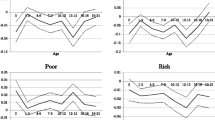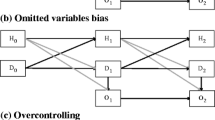Abstract
A large literature has documented the intergenerational transmission of socioeconomic status (SES). However, the mechanisms by which SES transmits across generations are still little understood. This article investigates whether characteristics determined in childhood play an important role in the intergenerational transmission. Using data from the Cebu Longitudinal Health and Nutrition Survey, I document the extent to which childhood human capital accounts for the intergenerational SES correlation. My results imply that childhood health and nutrition, cognitive and noncognitive abilities, and early schooling account for between one-third and one-half of the relationship between parents’ SES and their offspring’s SES.
Similar content being viewed by others
Notes
This article investigates how much of the intergenerational transmission of SES can be explained by the fact that children born to higher-SES parents accumulate more human capital during their early childhood. It is possible that SES may also transmit across generations through other channels; for example, children born to higher-SES parents may inherit nonhuman capital and family “connections.” The analysis of these channels is beyond the scope of the current article.
For budgetary reasons, the survey used a single-stage cluster sampling; 33 barangays (17 urban, 16 rural) were randomly selected among 243 barangays.
Children are given no time limit to answer each question, and the difficulty of the questions increases throughout the test.
These figures were converted using the 2007 World Development Indicators by the World Bank.
Stunting and wasting were defined as a height-for-age and weight-for-age below 2 standard deviations based on the World Health Organization reference data.
Height-for-age and weight-for-age at 24 months are strongly correlated with birth weight even after parental SES is controlled for (results not shown in the table).
The system of Eq. 5 can be rewritten in matrix form as follows:
$$ x_{i}^{c}=\upbeta _{0}+\upbeta _{1}y_{i}^{p}+\upnu_{i}^{c}, $$(7)where
$$ x_{i}^{c}=\left( \begin{array}{c} x_{i}^{1,c} \\ \vdots \\ x_{i}^{K,c} \end{array} \right) ;\upbeta _{0}=\left( \begin{array}{c} \upbeta _{0}^{1} \\ \vdots \\ \upbeta _{0}^{K} \end{array} \right) ;\upbeta _{1}=\left( \begin{array}{c} \upbeta _{1}^{1\prime } \\ \vdots \\ \upbeta _{1}^{K\prime } \end{array} \right); \ \text{and }\upnu _{i}^{c}=\left( \begin{array}{c} \upnu _{i}^{1,c} \\ \vdots \\ \upnu _{i}^{K,c} \end{array} \right) . $$(8)In Table 9, I use weight-for-age instead of weight-for-height because there are no weight-for-height standards to compute Z scores for children in this age range.
One reason why height-for-age and weight-for-age may not be predictive of children’s schooling is that these were measured when children were 6–11 years old, rendering them poor proxies for health because they reflect both the outcome of the first growth spurt as well as the timing and trajectory of the second. Unfortunately, no other information was collected both for the cohort members and their siblings that could be used as an alternative proxy for health.
The normalized regression coefficients are not reported in the table.
References
Atkinson, A., Maynard, A., & Trinder, C. (1983). Parents and children: Incomes in two generations. London, UK: Heinemann.
Aughinbaugh, A., & Gittleman, M. (2003). Does money matter? A comparison of the effect of income on child development in the United States and Great Britain. Journal of Human Resources, 38, 416–440.
Baum, C. L. (2003). Does early maternal employment harm child development? An analysis of the potential benefits of leave taking. Journal of Labor Economics, 21, 409–448.
Becker, G. S., Philipson, T. J., & Soares, R. R. (2005). The quantity and quality of life and the evolution of world inequality. American Economic Review, 95, 277–291.
Becker, G. S., & Tomes, N. (1976). Child endowments and the quantity and quality of children. Journal of Political Economy, 84, S143–S162.
Behrman, J. (1997). Mother’s schooling and child education: A survey (PIER Working Paper 97-25). Philadelphia, PA: Penn Institute for Economic Research.
Behrman, J., & Knowles, J. C. (1997). How strongly is child schooling associated with household income? (PIER Working Paper 97-22). Philadelphia, PA: Penn Institute for Economic Research.
Behrman, J. R, Pollak, R. A., & Taubman, P. (1982). Parental preferences and provision for progeny. Journal of Political Economy, 90, 52–73.
Behrman, J. R., & Rosenzweig, M. R. (2002). Does increasing women’s schooling raise the schooling of the next generation? American Economic Review, 92, 323–334.
Black, S. E., Devereux, P. J., & Salvanes, K. G. (2005a). The more the merrier? The effect of family size and birth order on children’s education. Quarterly Journal of Economics, 120, 669–700.
Black, S. E., Devereux, P. J., & Salvanes, K. G. (2005b). Why the apple doesn’t fall far: Understanding intergenerational transmission of human capital. American Economic Review, 95, 437–449.
Black, S. E., Devereux, P. J., & Salvanes, K. G. (2011). Older and wiser? Birth order and IQ of young men. CESifo Economic Studies, 57, 103–120.
Bowles, S., & Gintis, H. (2002). The inheritance of inequality. The Journal of Economic Perspectives, 16(3), 3–30.
Bowles, S., & Nelson, V. I. (1974). The “inheritance of IQ” and the intergenerational reproduction of economic inequality. Review of Economics and Statistics, 56, 39–51.
Breierova, L., & Duflo, E. (2004). The impact of education on fertility and child mortality: Do fathers really matter less than mothers? (NBER Working Papers 10513). Cambridge, MA: National Bureau of Economic Research.
Caldwell, J. C. (1979). Education as a factor in mortality decline: An examination of Nigerian data. Population Studies, 33, 395–413.
Case, A., Fertig, A., & Paxson, C. (2005). The lasting impact of childhood health and circumstance. Journal of Health Economics, 24, 365–389.
Case, A., Lubotsky, D., & Paxson, C. (2002). Economic status and health in childhood: The origins of the gradient. American Economic Review, 92, 1308–1334.
Chevalier, A. (2004). Parental education and children’s education: A natural experiment (IZA Discussion Papers No. 1153). Bonn, Germany: Institute for the Study of Labor.
Currie, J. (2009). Healthy, wealthy, and wise: Socioeconomic status, poor health in childhood, and human capital development. Journal of Economic Literature, 47, 87–122.
Currie, J., & Madrian, B. C. (1999). Health, health insurance and the labor market. In O. Ashenfelter, & D. Card (Eds.), Handbook of labor economics (Vol. 3C, pp. 3309–3416). Amsterdam, The Netherlands: Elsevier.
Datar, A., Kilburn, M. R., & Loughran, D. S. (2010). Endowments and parental investments in infancy and early childhood. Demography, 47, 145–162.
Duflo, E. (2000). Grandmothers and granddaughters: Old age pension and intra-household allocation in South Africa (NBER Working Paper 8061). Cambridge, MA: National Bureau of Economic Research.
Eriksson, T., Bratsberg, B., & Raaum, O. (2005). Earnings persistence across generations: Transmission through health? (Memorandum 35/2005). Oslo, Norway: Oslo University, Department of Economics.
Filmer, D., & Pritchett, L. (1999). The effect of household wealth on educational attainment: Evidence from 35 countries. Population and Development Review, 25, 85–120.
Glewwe, P. (1999). Why does mother’s schooling raise child health in developing countries? Evidence from Morocco. Journal of Human Resources, 34, 124–159.
Glewwe, P., & Miguel, E. A. (2008). The impact of child health and nutrition on education in less developed countries. In T. P. Schultz, & J. Strauss (Eds.), Handbook of development economics (Vol. 4, pp. 3561–3606). Amsterdam, The Netherlands: Elsevier.
Grantham-McGregor, S. (2007). Early child development in developing countries. Lancet, 369, 824.
Grantham-McGregor, S., Cheung, Y. B., Cueto, S., Glewwe, P., Richter, L., & Strupp, B. (2007). Developmental potential in the first 5 years for children in developing countries. Lancet, 369, 60–70.
Grantham-McGregor, S. M., Powell, C. A., Walker, S. P., & Himes, J. H. (1991). Nutritional supplementation, psychosocial stimulation, and mental development of stunted children: The Jamaican Study. Lancet, 338, 1–5.
Guo, G., & Harris, K. M. (2000). The mechanisms mediating the effects of poverty on children’s intellectual development. Demography, 37, 431–447.
Guthrie, G. M., Tayag, A. H., & Jacobs, P. J. (1977). The Philippine non-verbal intelligence test. Journal of Social Psychology, 102, 3–11.
Handa, S. (1999). Maternal education and child height. Economic Development and Cultural Change, 47, 421–439.
Hansen, K. T., Heckman, J. J., & Mullen, K. J. (2004). The effect of schooling and ability on achievement test scores. Journal of Econometrics, 121(1–2), 39–98.
Heckman, J. J. (2006). The skill formation and the economics of investing in disadvantaged children. Science, 312, 1900–1902.
Heckman, J. J., & Masterov, D. V. (2007). The productivity argument for investing in young children. Review of Agricultural Economics, 29, 446–493.
Heckman, J. J., Stixrud, J., & Urzua, S. (2006). The effects of cognitive and noncognitive abilities on labor market outcomes and social behavior. Journal of Labor Economics, 24, 411–482.
Martorell, R., Behrman, J. R., Flores, R., & Stein, A. D. (2005). Rationale for a follow-up study focusing on economic productivity. Food and Nutrition Bulletin, 26(2), S5–S14.
Mulligan, C. B. (1999). Galton versus the human capital approach to inheritance. Journal of Political Economy, 107, S184–S224.
Paxson, C., & Schady, N. (2007). Cognitive development among young children in Ecuador: The roles of wealth, health, and parenting. Journal of Human Resources, 42, 49–84.
Plug, E. (2004). Estimating the effect of mother’s schooling on children’s schooling using a sample of adoptees. American Economic Review, 94, 358–368.
Plug, E., & Vijverberg, W. (2005). Does family income matter for schooling outcomes? Using adoptees as a natural experiment. Economic Journal, 115, 879–906.
Ruhm, C. J. (2004). Parental employment and child cognitive development. Journal of Human Resources, 39, 155–192.
Sacerdote, B. (2007). How large are the effects from changes in family environment? A study of Korean American adoptees. Quarterly Journal of Economics, 122, 119–157.
Smith, J. P. (1999). Healthy bodies and thick wallets: The dual relation between health and economic status. Journal of Economic Perspectives, 13, 145–166.
Smith, J. R., Brooks-Gunn, J., & Klebanov, P. (1997). Consequences of living in poverty for young children’s cognitive and verbal ability and early school achievement. In G. J. Duncan, & J. Brooks-Gunn (Eds.), Consequences of growing up poor (pp. 132–189). New York: Russell Sage Foundation.
Solon, G. (1999). Intergenerational mobility in the labor market. In O. Ashenfelter, & D. Card (Eds.), Handbook of labor economics (Vol. 3A, pp. 1761–1800). Amsterdam, The Netherlands: Elsevier.
Taylor, B. A., Dearing, E., & McCartney, K. (2004). Incomes and outcomes in early childhood. Journal of Human Resources, 39, 980–1007.
Thomas, D., Strauss, J., & Henriques, M.-H. (1991). How does mother’s education affect child height? Journal of Human Resources, 26, 183–211.
Waldfogel, J., Han, W.-J., & Brooks-Gunn, J. (2002). The effects of early maternal employment on child cognitive development. Demography, 39, 369–392.
Acknowledgements
I am grateful to Anne Case, David Lee, Chris Paxson, and Sam Schulhofer-Wohl for their advice and support. I am also indebted to Silvia Helena Barcellos, Deforest McDuff, Ashley Ruth Miller, Francisco Perez Arce Novaro, Heather Royer, Jim Smith, and seminar participants at Princeton University. All remaining errors are mine.
Author information
Authors and Affiliations
Corresponding author
Electronic Supplementary Material
Below is the link to the electronic supplementary material.
Rights and permissions
About this article
Cite this article
Carvalho, L. Childhood Circumstances and the Intergenerational Transmission of Socioeconomic Status. Demography 49, 913–938 (2012). https://doi.org/10.1007/s13524-012-0120-1
Published:
Issue Date:
DOI: https://doi.org/10.1007/s13524-012-0120-1




